Emovior: Visible Voice
A THESIS ON CHILDREN'S LEARNING & EMOTIONAL BEHAVIORS
On learning & emotional behaviors.
Emovior: Visible Voice was the author’s MS graduation thesis at the Department of Graduate Communications Design at Pratt Institute. It was completed along with an exhibition in New York in May 2013. This thesis looks at the complex and intricate relationship between children’s education and learning environments and proposes ways of optimizing the learning experience through communications design and technological enhancements.
This thesis introduces the term ‘emovior’ (emotional-behavior) to describe the interaction between three key aspects of an innovative learning experience: transformative environments, visible expression, and emotional and behavioral technology. It endeavors to evidence that children’s learning experience can be largely enhanced by environments with transformative spatial language, highly visualized dimensions of expression, and real-time responsive emotion- and behavior-driven interfaces.
Part I: Transformative environments.
Every space speaks a unique language, defined by the objects within it. The shape and structure of a space conveys dimensional messages through spatial experiences. The concept of space, the void, is a profound part of our experience as humans. It is something we experience primarily through the containers used to control and define that space. Emovioral learning methodologies explore three concerning aspects in children’s learning environment: 1) designing learning spaces: structure versus changeability; 2) experiential surroundings: reception and perception; and 3) metacognitive skills: questioning and communicating.
Part II: Visible expression.
Children’s self-expression is a mosaic of complex layers of emotional fragments, combining vocalizations, physical expressions and attempts to interact with their surroundings. When contextualized, these fragments often cause frustration for the child and confusion for the subject of the intended communication. Emovioral learning methodology looks at children’s expression from three aspects—troubled words, tangled thoughts, and confused tools. It posits visual interpretation as a crucial tool in bridging the breakdown between expression and comprehension. By introducing tools that can provide a reference point, educators and students can develop a common language of expression.
Part III: Emotional & behavioral technology.
‘Emovior’ is defined as a method of expression formed by the combination of complex emotions and behaviors. One way to make emotions and thoughts visible is to design environments and tools which stimulate creative emotional expression. This emotional expression and also children’s non-quantified behavior provides a rich resource from which we can assess human potentials at an early stage. These emotional-behavioral interactions are more experiential when they are real-time and symbiotic. Using the data gathered in this way, educators are able to design more efficient educational methodologies.
Emovioral learning emphasizes the importance of looking at emotion and behavior as a synchronized activity; therefore, translating them both separately and collaboratively is equally important and valuable. Emotive (neuroscience technology) and Kinect (motion-sensing technology) are introduced in this thesis to exemplify the possible outcomes of emovioral learning.

An exhibited work.
This thesis project was exhibited at the Graduate Communications Design Studio in New York in 2013. The author introduced this project to faculty members from various academic disciplines both from Pratt and other institutes, visiting guests from diverse industries, and many other design students.
From theory to practice.
The author took ideas and suggestions shared since the introduction of this project to further research and visits at various learning facilities around the world. He continues his endeavors to build the platform Emovior.

The journey continues…
‘This, for me, is the most beautiful and the saddest landscape in the world. It is the same landscape as on the previous page, but I have drawn it again to show you. It is here that the little prince appeared on Earth, and then disappeared. Look carefully at this landscape so as to be certain to recognize it if you travel to the African desert one day. And, if you happen to pass by this place, I urge you not to hurry, but to wait a little under the star. If you come across a golden-haired child who laughs and never answers your questions, you will know who he is. So, please, write and comfort me by telling me he has come back.’
—from The Little Prince, by Antoine de Saint-Exupéry












